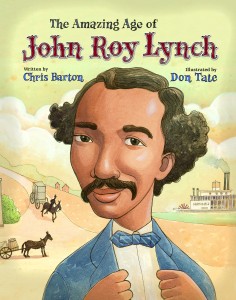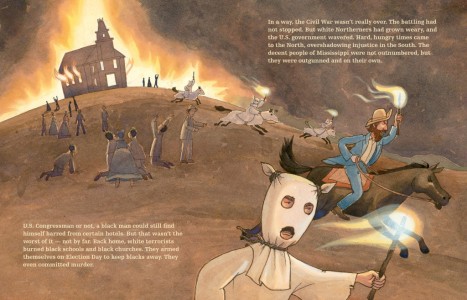This story of John Roy Lynch, the first African-American speaker of the Mississippi House of Representatives, is a terrific book for several reasons. The most important is, the author actually gets the story of the Reconstruction Era correct. While many Americans know a lot about the Civil War, the great majority don’t know much about Reconstruction, and what they have learned is riddled with myth and inaccuracies. As historian Eric Foner points out, we are still dealing with many of the same issues today as we did during this time period, making it all the more critical that we are aware of what actually happened. Chris Barton does a great job not only in presenting the truth, but in doing so in a way that will be understandable to younger readers.
Another reason this book stands out is because of John Roy Lynch himself, whose story is pretty amazing. Lynch, his mother, and brother were slaves, but were about to be bought and thereby liberated by his white father in 1849 when the father became sick and died. The father had entrusted a friend to complete the process, but the “friend” just sold the family to a new owner.
John Roy’s new job was to serve the owner’s wife by such chores as fanning her and shooing flies from her food. On Sundays, he and the other slaves listened to sermons about doing their master’s will. But John Roy spoke out of place one day, and was sent across the river in 1862 to work in the swampy cotton fields. But by then the Civil War had started, and when the Yankees came to Mississippi, John Roy experienced “true emancipation” when he sold a chicken for a dime and bought a boat ride to Natchez.
After the war ended, Mississippi whites, like those in other parts of the South, began passing laws to incarcerate as many young black men as they could; in essence, re-enslaving them to use their manpower as before. The labor of prisoners was bought and sold by sheriffs and judges among other opportunists to corporations such as U.S. Steel, Tennessee Coal, railroads, lumber camps, and factories. The prisoners who were sent to mines were chained to their barracks at night, and required to work all day. Hundreds died of disease, accidents, or homicide, and in fact, mass burial fields near these old mines can still be located. (You can read about this in the excellent 2008 book by Douglas Blackmon, Slavery By Another Name.)
John Roy managed to escape “recapture” by becoming a messenger for a local portrait shop, and was soon running it himself. He went to night school to learn to read and write, and got involved in the Natchez Republican club.
In 1868 the new U.S. Government-appointed Governor of Mississippi named John Roy Justice of the Peace, and John Roy hastened to learn law. He then got elected to the Mississippi House of Representatives, which chose John Roy as Speaker of the House. He was still only twenty-four years old. In 1872, voters sent him to the U.S. House of Representatives. His own success belied the fact that there was still plenty of resistance to black advancement in the South, and violence by whites steadily increased. John Roy, however, continued throughout his long life to believe in the power of law to bring peace and justice.
John Roy Lynch’s story is followed by a timeline, an Author’s Note, Illustrator’s note, a list of references for further reading, and a map.
Illustrator Don Tate chose a “childlike, naive style of art,” as he explains in his note, in the hope that the more lighthearted style would help temper the harsh aspects of the story. I think he made a great decision. His watercolors are also framed in sepia, helping establish the historical nature of the story.
Evaluation: “Black history” has been dominated for so long by a very few figures, that it is great to see authors bringing attention to new trailblazers and role models. And as mentioned above, it is always very gratifying when an author does his or her research, and is not reluctant to figure out ways to share essential aspects of American history with younger ears.
Rating: 5/5
Published by Eerdmans Books for Young Readers, 2015
Filed under: Book Review, History | Tagged: Book Review, History |








Leave a comment